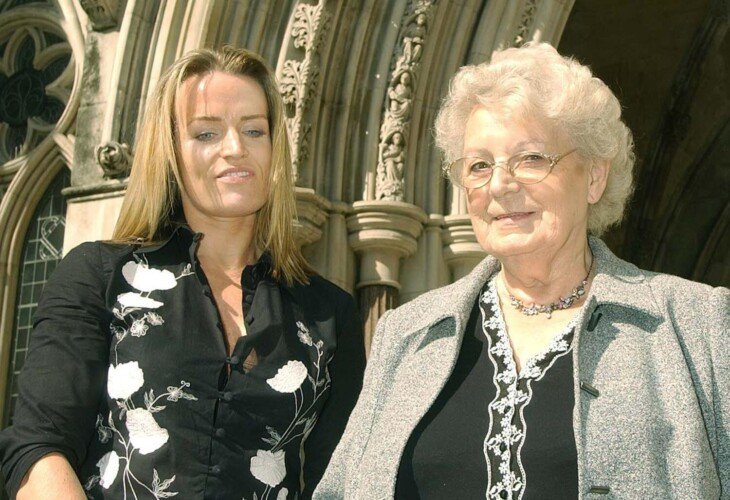‘A severe miscarriage of justice’: Case of last woman hanged in Britain called into question
The grandson of the last woman to be hanged in Britain is calling for the case to be brought back into court.
Former Tooting resident Ruth Ellis, was 28 years old when she was hanged on the morning of July 13, 1955, at Holloway prison, north London.
The mother of two had been convicted of murdering her lover, David Blakely, in a public shooting.
Now, Ellis will be portrayed by actress Lucy Boynton in the ITV production A Cruel Love: The Ruth Ellis Story, which will be aired from March 2.
Ahead of the release date, Ellis’ grandson, Stephen Beard, 36, has said the judge did not have to sentence Ellis to death.
Instead, he argues, the conclusion should have been a case of “both battered woman syndrome and diminished responsibility”.

He is now calling for his grandmother’s case to be looked at in court once again.
“I’m not saying that Ruth should be reprieved because she did murder a man but the fact that the judge decided that the only sentence he could impose because of the admittance of premeditated murder was hanging was incorrect”, Mr Beard told The Times.
He said: “There was such a severe miscarriage of justice, which will be explained through the series, that I wonder whether there is a KC who believes there’s enough substance and weight here for Ruth’s case to be taken back to the courts.”
With striking bleached blonde hair, her face paled with powder and drawn with bright red lipstick, Ellis was known to work at the Locarno, in Streatham.
Mr Beard also argues that her lifestyle, as a night club hostess who was expected to have sex with her customers if required, counted against her in court.
It was whilst working in a night club that Ellis met Blakely, and their romance quickly bloomed.
But passion soon turned sour and their relationship became dysfunctional and violent. By April 1955, Ellis reached her breaking point.
On Easter Sunday, she walked into the Magdala Pub in Hampstead where Blakely was drinking.
With her, she brought RAF officer Desmond Cussen – a man whom she had a brief relationship with – as well as the gun he had given her.
Ellis shot Blakely twice as he left the pub, before firing another two rounds into his body as he lay on the ground.
She asked for the police to be called and did not resist arrest.

A report from the Home Office file into the case identified Blakely’s violent nature.
The file recorded how Ellis had been admitted to hospital with multiple bruises and had suffered a miscarriage in the weeks prior to the murder, believed to have been caused by Blakely punching her in the stomach.
During her trial, neither of these facts were considered significant enough to reduce her sentence from murder to manslaughter.
As for Cussens, he failed to tell detectives that he had given Ellis the gun, shown her how to use it and driven her to the murder scene. He walked free.
Ellis was executed after a trial at the Old Bailey, where the jury took just 14 minutes to convict her.
According to the Daily Mirror, she was “the calmest woman who ever went to the gallows”.
Ellis’s execution led to a worldwide uproar and played a significant role in the decision to abolish capital punishment in Britain.
The nation seemed to be able to relate with the 28-year-old mother-of-two. They saw her actions as “passionate”, “compulsive” and “desperate”, but also human.
Letters were penned to politicians, petitions signed and campaign headlines swept across the nation’s press.

Within two years of Ellis’ death, the Homicide Act came into effect which limited the death penalty to certain types of murder.
This set the tone for what was to follow in 1965, when Harold Wilson’s Labour government passed the Abolition of the Death Penalty Act.
The Ellis case was referred back to the Court of Appeal by the Criminal Cases Review Commission (CCRC) in 2003. The Court rejected the appeal and made clear that it could rule only on the conviction based on the law as it stood in 1955.
But, the complex relationship between abused women and the British legal system remains at the centre of serious debate.
In 2021, the Centre for Women’s Justice published Women Who Kill: How The State Criminalises Women We Might Otherwise Be Burying.
The report concluded four years of research into the criminal justice response to women who kill abusive men.
Through interviews with key practitioners within the system, and women themselves, the paper explores the extent to which the law, and the way the law is applied, affects women’s access to justice.
Pictured top: David Blakely and Ruth Ellis at the Little Club in London, 1955, the year of their deaths (Picture: Trinity Mirror / Mirrorpix / Alamy Stock Photo)
